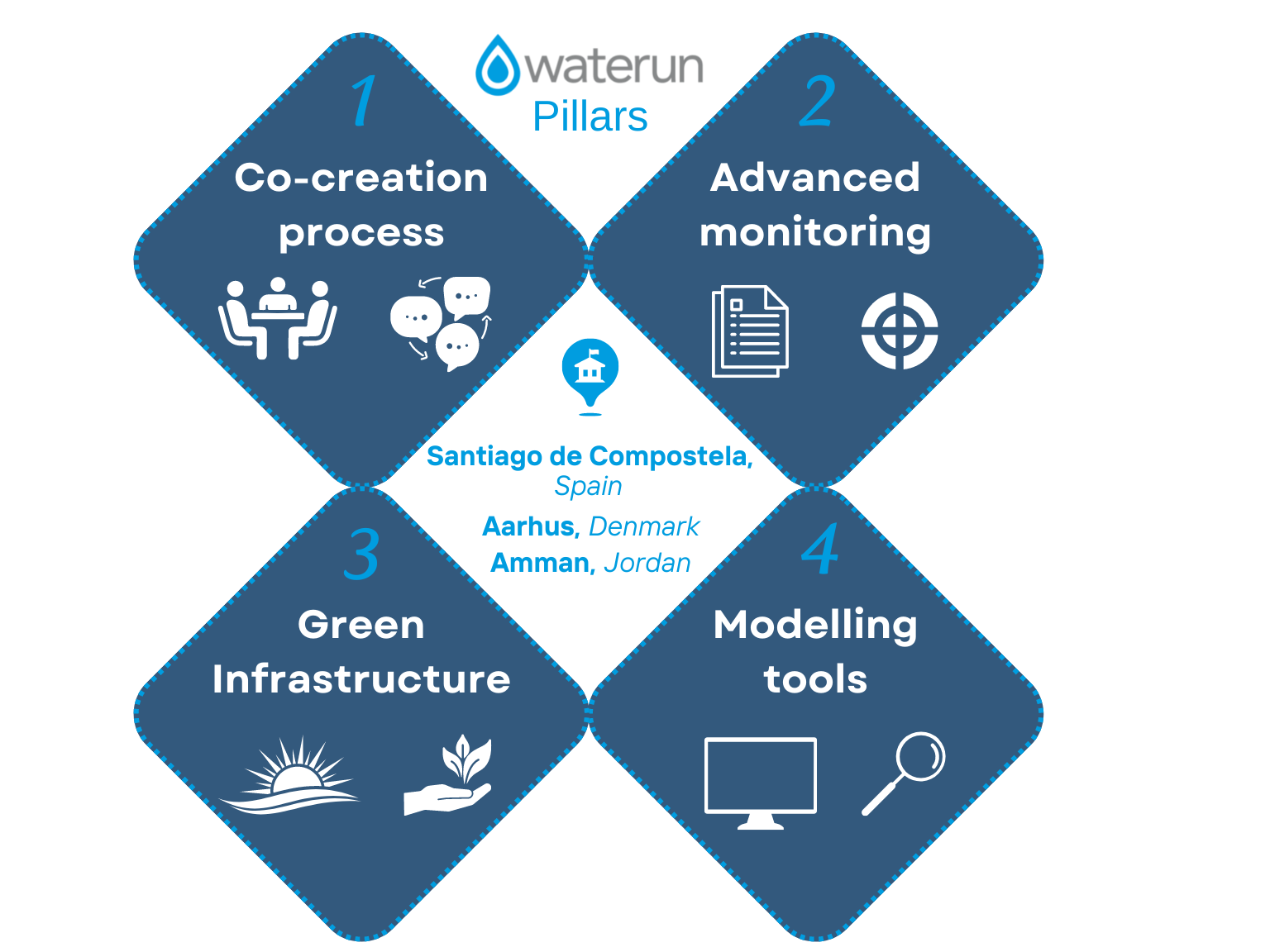Method
WATERUN will accomplish an innovative methodology to address diffuse pollution in UWR by the implementation and validation of prevention (effective monitoring techniques and modelling tools) and mitigation. The method is based on four pillars

Pillar 1: Co-creation process for preventing and managing diffuse pollution from UWR in cities
Pilla 1 a novel method for establishing UWR management plans based on WSUD approach must be adopted from a multidisciplinary point of view considering the vision, knowledge, and expertise of different key stakeholders (water utilities, public authorities, water regulators, water engineering companies, research community and citizens). In this sense, WATERUN methodology will be adopted from the beginning through a co-creation process involving the key stakeholders in the developments, implementations and validations of the project outputs and results.
Pillar 2: Development of advanced monitoring for diffuse pollution in UWR
AIMEN will lead in WP2 the elaboration of a long-term monitoring protocol based on field campaigns and data analyses to increase the level of understanding of conditions at each CS, fill data gaps and move forward with the implementation of hydrological and hydraulic models to understand diffuse pollution patterns. This protocol will gather information about hydrological processes, key pollutants, background concentration levels in water and soil samples, topographic surveys, demographic information, etc. Thereafter, the most sensitive parameters for detection, modelling and mitigation of diffuse pollution will be estimated, and the frequency of measurements and sample collection in the urban catchment will be designed. Factors such as location, season, rainfall, runoff, water quality and origin/fate will be considered to provide a solid approach towards the understanding of varying patterns of pollutant release and transport.
Pillar 3: Development of modelling tools for diffuse pollution identification, SW management and risk, and UWR quality management plans
In WATERUN, 3 modelling tools will be developed and validated to improve the UWR management in cities:
1 - Identification tool for critical sources of urban diffuse pollution based on a connectivity assessment (WP3).
2 - Planning tool for SW management based on a decentralised approach at city block level (WP3).
3 - Risk-based DSS for UWR management and reuse based on environmental and health-risk assessment (WP5).
The identification tool (WP3, TUB) will provide global and qualitative information about the critical sources of pollution, pathways, severity ranking and locations for GI. Once the GI locations are identified, the risk-based DSS (WP5, UNIVPM) will give quantitative info about UWR quality (QMRA and QCRA) from a health-risk perspective, delivering the EWS providing indication on restrictions of the water use and allowing to assess the suitability of GI for different reuse scenarios (risk-based tool). Complementary, when GI are not considered suitable to reduce diffuse pollution in a specific location, the planning tool (WP3, UFZ) will be implemented for UWR and CSO reduction at city block level and based on a decentralised approach, which involves an intrinsic pollution reduction. All modelling tools will be connectable, and they will work as an integral methodology for UWR management.
Pillar4: Implementation and validation of Green Infrastructure for diffuse pollution mitigation from UWR
GI involve many sustainable techniques for UWR management from a WSUD point of view, comprising various technologies as SuDS, NBS or low impact developments. GI provide a new approach to UWR drainage and treatment planning that keeps water on site longer, prevents pollution and allows storage and use of the water.
In the Santiago and Aarhus CS, a comprehensive analysis of the components of the urban and industrial development sensitive to water (WSUD) by using GI will be performed. This analysis will be facilitated through the co-creation process (WP1), monitoring strategy (WP2), and UWR/SW modelling studies (WP3). After this urban and industrial development analysis of the CS, a strategy for the implementation and validation of GI based on SuDS and NBS will be developed in WP4 (GI implementation) with the collaboration of stakeholders in WP1 (co-creation process), considering not only the interaction of different types of water, but also the components of governance and economic, social and environmental feasibility, as well as the links of the urban water system with other urban infrastructures, such as transport, green areas, waste management, or energy, among others.